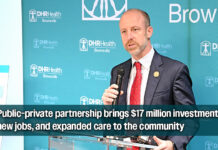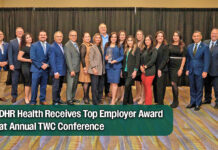By Roberto Hugo Gonzalez
As originally published by Mega Doctor News in its newsprint edition March 2018
Technology has made many changes in every industry; the field of medicine is no exception. Every day, you read and hear about the new advancements in imaging, which help doctors help their patients get better.
Dr. Allan Kapilivsky, a Valley radiologist, has seen his profession transformed by changes in digital technology. These sweeping advancements are a world apart from the days when radiologists used to work with conventional radiology films, dark rooms, and wet reads.
As a medical doctor and radiologist, Dr. Kapilivsky’s job is to help his colleagues diagnose their patient’s ailments and offer suggestions in treatment options. Today’s radiology offers safer and more accurate diagnosis, eliminates needless and invasive surgical procedures, and provides more effective treatment options.
Through the use of medical imaging equipment such as X-rays, computed tomography (CT), magnetic resonance imaging (MRI), nuclear medicine, positron emission tomography (PET), mammography, and ultrasound, the inside of the human body can be imaged, and medical decisions can be made without the need of exploratory surgery. Clinicians’ acumen with the support of medical imaging, can diagnose more accurately, sooner and less invasively most of the patients’ problems and can help advance the realms of preventive medicine. Yes, it sounds complicated, and it is. Dr. Kapilivsky has been practicing for the last 23 years.
When Dr. Kapilivsky was growing up in Lima, Peru, he spent plenty of time in the world of medicine because his father, Dr. Jacobo Kapilivsky, is a prominent surgeon whom he admires very much. He always knew he wanted to be a doctor. That was the easy part of the decision. However, when it came to the point of choosing a specialty, he found himself at a crossroads. He wondered which area of medicine he should select. Choosing a trade is not easy, especially when you know that your future is at stake.
“Well, my father is a surgeon, so I grew up among doctors in hospitals all my life. When it was time to decide what I wanted to do with my life, obviously, I chose medicine,” said Dr. Kapilivsky. “I was trying to decide what kind of medicine I wanted to practice. My father said, ‘You like photography, and you like computers, so go be a radiologist.’”
Now, in 2018, he says, “My father was right. After finishing my medical school in Peru, I applied for radiology, and I went through the long, arduous training. I did medical school in Peru, but I did all my postgraduate studies in the United States.”
Dr. Kapilivsky obtained his Medical Doctor degree in March of 1986 in Peru. After finishing medical school, he did a year of medical internship in Baltimore, Maryland and completed a residency in nuclear medicine in Cincinnati, Ohio. Afterward, he completed his residency in radiology at Albert Einstein Medical Center in Philadelphia, Pennsylvania. That year he also earned the American Board of Radiology Certification.
After graduating, he came to the Valley where he has lived with his family ever since. All of this training has taken many years of preparation, in order for Dr. Kapilivsky to feel confident with his work and responsibility as a radiologist.
Studying in the United States did not feel strange to him; the family used to spend vacations along the east coast. “We used to come all the time, and my parents encouraged me to learn English.” He continued, “So, I was fluent in English before I came to the United States for my postgraduate medical training.”
Since arriving in the Valley, he has worked in McAllen Medical Center and Mission Regional Medical Center. From 1997-2004, he worked at the McAllen Heart Hospital as Medical Director in the department of radiology. In2004, he came back to McAllen Medical Center as Director of the radiology department. In2008, he accepted a full-time position at Knapp Medical Center in Weslaco. Now, after working for 22 years in different institutions, he decided to work from a private medical office, continuing his career in the field of radiology, but in an outpatient setting.
He is currently working with McAllen MRI Center as the lead radiologist. The center has the only true open, stand-up MRI in the Valley. It also provides services with a high-field MRI, high-speed CT scanner, ultrasound, and radiographic facility.
Dr. Kapilivsky thought that working outside of a hospital setting would change his work pace, but the center is open Monday to Sunday, 8 am to 11 pm, so he is still as busy as before. Besides McAllen MRI Center, he also works with different local doctors and institutions throughout the Valley.
Doctors around the area trust Dr. Kapilivsky, his experience is put in practice for the benefit of the patients. Even though we live in a digital world, a personal, close relationship between specialties is still needed to do a successful job.
The work that both professions provide for the general public is one of a kind. When a family doctor and a radiologist like Dr. Kapilivsky get together to diagnose a patient’s problem, it’s done with care, knowledge, and experience. Radiologists playa crucial role in the patient’s healthcare by providing accurate and fast diagnosis, by offering better and less invasive treatment options, and helping doctors monitor the progression or regression of disease.
What challenges have you encountered in your profession?“I think the biggest issue that we have in medicine in general and radiology, in particular, is communication.” He continued, “Communication between the patient and the doctor, because if the patient cannot verbalize what he feels or explain himself or herself, it makes the job of the physician more difficult to diagnose the malady and make decisions. Language barriers and regional idioms also play a confusing role.”
The communication between the doctor and the radiologist is also essential, because like Dr. Kapilivsky says, if both sides don’t offer a complete picture of the patient’s problem, the job of the radiologist becomes ‘quite tricky” and the patient may not get the adequate and prompt care at the lowest cost.
The radiologists are medical consultants and by providing them with pertinent clinical information and by knowing what specifically the clinician’s concern is, the radiologists can provide a more adequate report that specifically addresses the issues at hand and may be able to better offer diagnostic tests available or suggest treatments that may help the patient in question.
Aside from communication, the other challenge is the constant learning due to the evolution of technology. That, in reality, is not a challenge because learning is always satisfying. For example, he says, “Protocols for MRI are continuously evolving. CT scanners are much faster.” He said, “We can do a lot of fancy stuff that we didn’t use to do and we can tailor the exams with the different modalities and protocols to address the specific issues presented by the patients.”
What attracted you to come to the Valley? “I grew up in Peru, and this is the closest that I have to Latin America. This is almost like being back home.” He continued, “The culture is very similar. The language is my language. The food is almost my food. So, this was the nicest place I could have chosen. It is the type of culture and environment I’m used to, and I like it here.”
When he came here for the first time, he didn’t know anybody; he said that many people have embraced him and his family and helped him in many ways. He said, “We’re very grateful to so many people who have helped us and protected us.”
He says his favorite hobby is, “Traveling with my wife, Lillian. We’ve been to so many places and have had so much fun. I would say Barcelona is one of my favorites cities but going to Morocco was amazing.”
Dr. Kapilivsky has been to many places around the world. “Traveling opens your mind and your eyes. You see different cultures, taste different foods, talk to people from many different countries. These experiences teach you about the beauty of diversity and make you appreciate what you have at home.”
Would you like to add to this conversation? “It’s important for people to know that medicine is a very complex affair. Everybody has to be part of the healing process. This is teamwork.” He said, “The patient has to be actively involved in his or her care with the help of the doctor, the nurses, the radiology team, and even the people at the front desk, and his or her family.”
He said, “Because if one part falls apart, it becomes tough to provide good medicine. The end-goal is to help patients and that is why we studied so much and why we are here at their service.” Dr. Kapilivsky said, “I want to remind you that adequate communication is crucial to giving the patient the best possible outcome,” he finalized.
Dr. Kapilivsky has been selected as the Mega Doctor for this month for the love he feels for this exciting field of radiology. He works from his private office servicing the medical community in the Valley.




















